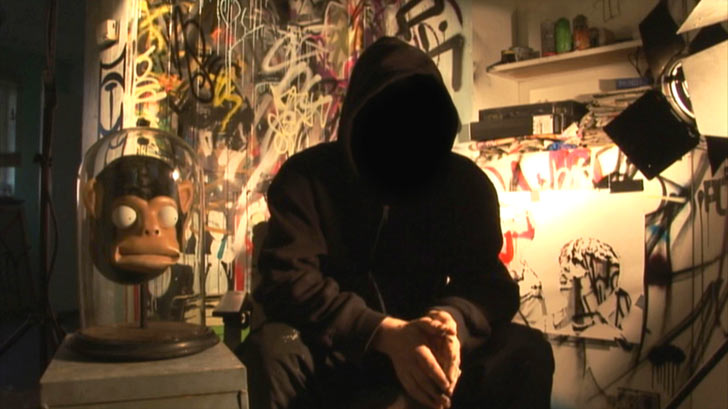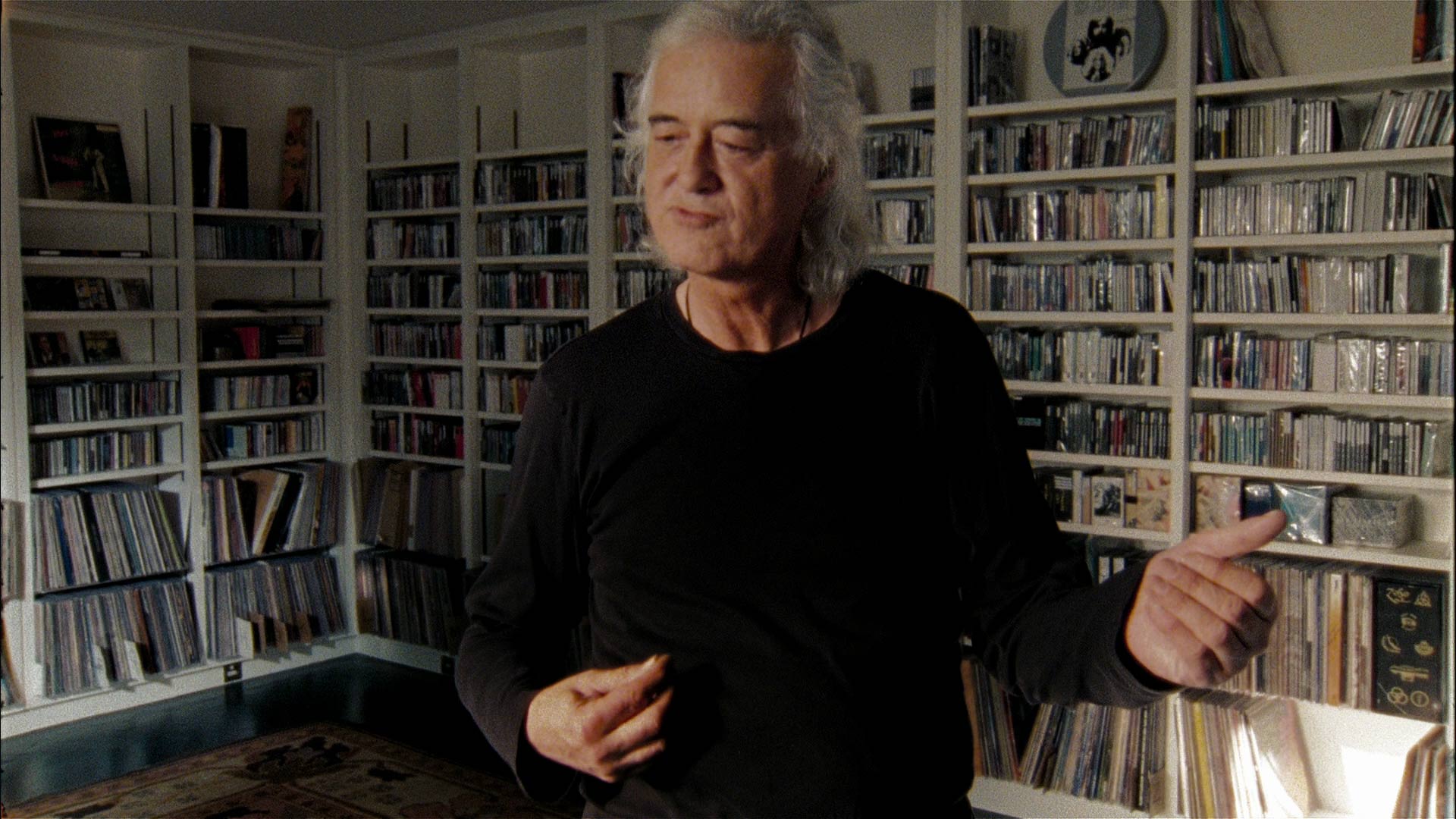Exit Through the Gift Shop
 No doubt at least a little bored with his status as the standard-bearer internationally for street art, Banksy takes his career to the next logical step with this documentary-essay film. Exit Through the Gift Shop purports at first to chronicle the street-art movement, vérité style, but eventually reveals itself as a treatise on Bad Art and a screed against what the film argues are tone-deaf patterns of consumption that drive trends in the art world.
No doubt at least a little bored with his status as the standard-bearer internationally for street art, Banksy takes his career to the next logical step with this documentary-essay film. Exit Through the Gift Shop purports at first to chronicle the street-art movement, vérité style, but eventually reveals itself as a treatise on Bad Art and a screed against what the film argues are tone-deaf patterns of consumption that drive trends in the art world.
The film is constructed initially like a straightforward doc. The footage assembled depicts Banksy, Shepard Fairey, and other renowned street artists at work, stenciling and wheat-pasting their iconic designs in public and conspicuous places. But much attention is paid to the documentarian himself. Thierry Guetta is, apparently, a camera-mad Frenchman living in Los Angeles whose entrée to the street-art scene is his cousin, known as Invader, who created little tile mosaics of alien characters modeled on the old-school videogame Space Invaders for display in unlikely urban locations. Guetta gets a kick out of pointing a camera at anything and, because street art is by its very nature ephemeral, Invader and others in the movement welcome his presence as a kind of preservationist. So singular is his reputation as cameraman for the post-graffiti movement that he even insinuates himself into the life of the reclusive and secretive Banksy (seen on screen only from beneath the identity-cloaking cowl of an apparently magical hoodie that puts his face in complete shadow), who uses him as both location scout and documentarian on a visit to Los Angeles.
SPOILERS BEGIN HERE
When it comes time for Guetta to assemble boxes and boxes of tapes accumulated over years and years of shooting, he is revealed as a reliable imagemaker, but a useless filmmaker. Footage purportedly taken from Guetta's first cut of his street-art documentary is hilariously naive and self-absorbed. Banksy responds to the travesty by suggesting that Guetta take some time off from the project and indulge some of his own creative impulses. Energized by the suggestion, Guetta cashes in his savings and cranks out immense quantities of "artwork" -- prints and paintings riffing mainly on celebrities, and highly derivative of other 20th century pop artists, that he endeavors to sell at outrageous prices. Bolstered and emboldened by friendly pull quotes from Fairey and Banksy himself — though Banksy's blurb is pointedly backhanded — Guetta renames himself Mr. Brainwash, mounts a splashy solo exhibition, and takes L.A. by storm.
Reviewers have been somewhat cagey about calling this the hoax film that it obviously is. (At least as I keep going over it in my head, I come to the conclusion that it must be — I can't think how it could come into being any other way.) I can't figure out if this is a certain credulousness at work, a just-in-case tactic for hedging their bets, or a desire to become co-conspirators with Banksy — to be in on the joke by perpetuating the prank.
Or maybe they're just reluctant to spoil the fun of seeing this for yourself. It's a good prank, obviously a long time in the making. The documentary footage is consistently intriguing and historically valuable. The closing credits acknowledge a ton of sources for archival footage, certainly more than you'd expect to be included if Guetta had been quite as profligate a real-life videographer as the film makes him out to be, or if the film was legitimately meant to be drawn from his amassed footage. It's also unclear how real Thierry Guetta is -- though his alter-ego seems to have been judged authentic by the marketplace. Either he is a character written and performed from scratch as a vehicle for Banksy's mockery of the art market, or the real-life Guetta is a willing accomplice being guided by Banksy's hands behind the scenes. As far as I can tell (from Googling, not actual research), Mr. Brainwash really did have a wildly successful solo exhibition in Los Angeles, and "his" work — no matter who may actually be driving the concepts and execution -- really has been selling for tens of thousands of dollars to collectors chasing the next big thing. Apparently he really did design the cover art for a greatest-hits collection from Madonna, that old art hag. But in this context it's implausible that he's an artist acting in anything resembling good faith. Enamored of superficial ideas, overly reliant on defilement of existing imagery, and derivative to a fault, Mr. Brainwash is a necessarily bespoke emblem of the kind of thoughtless (dare I say vulgar?) cycle of high-value creation and consumption that Banksy rues in contemporary art. I can't imagine this creature could have evolved naturally, friends in high places or no.
What's most remarkable about the conception of Brainwash is the close-but-no-cigar status of his work, which recycles from Koons, Haring, Basquiat, etc. A typical piece depicts Alfred Hitchcock, in black-and-white, holding up a clapboard on which has been scrawled the bland slogan, "Life is Beautiful." There's a concept there, of course, having to do with the notion that one of the most macabre film artists was also one of the liveliest, most playful, and most enduringly vibrant. And it's also a butt-simple idea, so obvious an exercise in gentle dissonance that calling it a "concept" is giving it way too much credit. He turns machine-printed works into unique originals by dribbling paint on them. And then there's his seemingly endless variations on colorful prints of Marilyn Monroe's silhouette, her face replaced by that of one of dozens of contemporary celebrities, chosen apparently more or less at random. The idea might have some value as a derivative of Andy Warhol — if Banksy hadn't gotten there first, with a series that replaced Monroe's face with that of Kate Moss. One of the differences is that Banksy's work generally seems to attack the cult of celebrity, while MBW's work reads as a celebration of it. (Then again, what is Banksy's career as a fine artist if not a celebration of his own anonymous notoriety?)
If Mr. Brainwash's work, taken as a whole, can be said to have value, that value is pure cheek. Turns out cheek is part of the film's thesis. The success of an artist who begs, borrows and steals from his forebears, squeezing publicity juice out of blurbs from recognizable names like Banksy and Fairey, whose words are apparently gospel to a certain species of collector, is compelling evidence in any argument that the wealth-driven contemporary art scene has less to do with an aesthetic or moral connection between artist and audience and more to do with a collector's mentality -- the acquisition of impossibly dear pieces of canvas and lithography as high-class starfucking. That said artist is in part a fictional creation may undermine the argument in some ways (that is, by stacking the deck) but bolsters it in others (for example, by demonstrating how lucrative prefab art can be, even if it's built on a sensibility that's 100 percent horseshit). Guetta's work has so much Banksy in it that it seems likely Banksy is just having a great time here, taking some of his good ideas to ludicrous extremes and giving some of his bad ones the cachet they never deserved in the first place, signing it all with the sobriquet MBW, and fronting the whole thing with the hairy face of an opportunistic Frenchman.
What lends the whole project its much-remarked-upon funhouse quality is its ability to reveal questions behind questions. If we take Brainwash's status to be, essentially, that of a marionette (and I think we must, on the evidence), then what of the real, workaday bystanders who are brought into the picture, Borat-style? What about the manufacturing process for the artifacts themselves, which are created not by Brainwash but instead by a small army of artisans hired through Craigslist to execute on the sketchiest of Brainwash's ideas? Are any of those workers, some of whom are interviewed on camera, in on the joke? Do they suspect they're part of a huge flim-flam? And have they brought any genuine creativity to bear that should be acknowledged?
Further, if art collectors buy Mr. Brainwash pieces on their perceived merits as art, are they worthy of scorn? What if they suspect Banksy and Fairey are in on the deal, and are buying based on admiration for their status as artists? What if their Spidey sense is telling them the whole thing really is a massive con perpetrated by Banksy, which could make the pieces an excellent investment? Do we mock them as rubes or as cynics? If we're mocking them for poor taste, why do we get to decide what's good art and what's not? Why does Banksy? If Brainwash's art is a practical joke, does it necessarily forfeit its status as art? Finally, isn't this all Banksy's fault to begin with, the tosser?
Banksy, I think, is confident that Brainwash is making bad art, and he expects the audience for this film to agree. The closing scenes, in which Banksy and Fairey are seen speaking in guarded but clearly despairing terms about the meteoric ascent of Mr. Brainwash -- the monster they created -- are hilarious to a Spinal Tap degree. These scenes, in which the artists express regret over their role in provoking Mr. Brainwash to soil the very fabric of street art culture, are the punchline to an elaborate, intellectual, rigorously conceptual joke. Even as it stands, it's unlikely there will be many films this year that are more ambitious, or that deliver so generously on their own designs. Some viewers have speculated that this "Thierry Guetta" fella up on screen is Banksy himself, which seems a mite too unreasonably audacious. But if it were true, it would make this film one hell of a prank indeed, destined for the history books. That Banksy has pulled off the long con, his "bad art" commingling with his "good art" and creating something else again, while keeping a more or less straight face about it, only contributes to his already legendary status as a po-mo provocateur.
Posted by on May 3, 2024 8:15 PM


